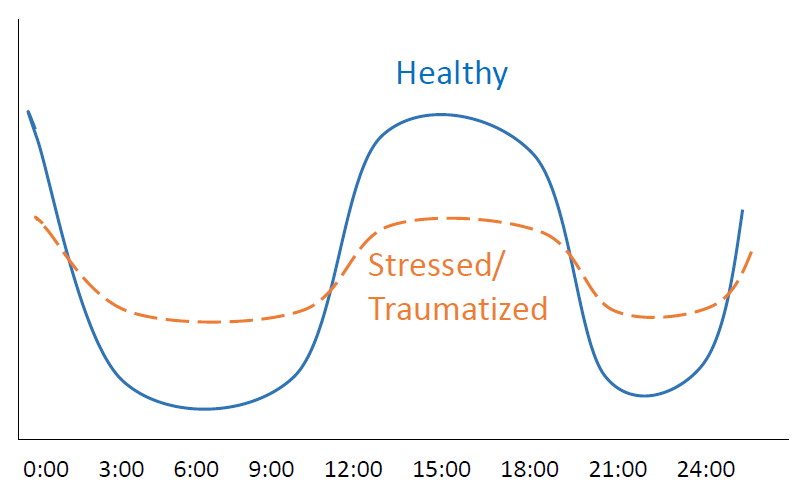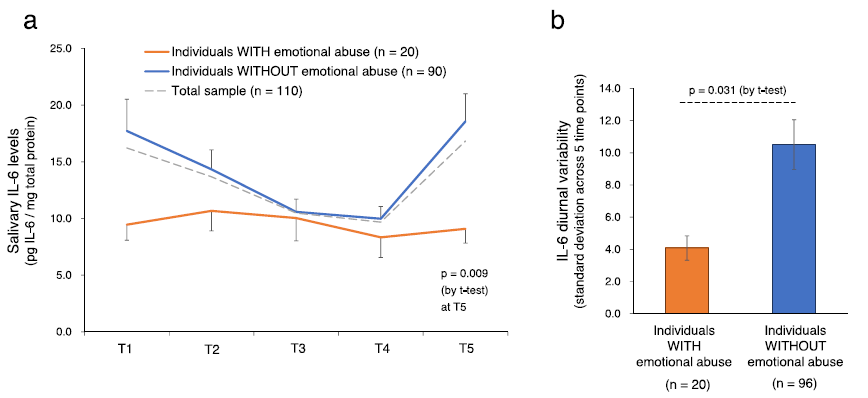Childhood maltreatment history is associated with blunted diurnal rhythm of the immune/inflammatory system
Summary
The research group led by Section-chief Hiroaki Hori, Department of Behavioral Medicine, National Institute of Mental Health, National Center of Neurology and Psychiatry; and Professor Yuko Hakamata, Department of Clinical and Cognitive Neuroscience, Toyama University School of Medicine, revealed that people who experienced childhood maltreatment have blunted diurnal rhythm of interleukin-6 (IL-6) 1) in their adulthood. Childhood maltreatment history is known to increase risk of mental and physical diseases in later life. This study is the first to demonstrate that the childhood maltreatment history is associated with perturbed secretion patterns of IL-6, suggesting that childhood maltreatment might have a long-lasting effect on diurnal patterns of immune/inflammatory system, thereby possibly leading to the development of various mental and physical diseases.
The findings of this study were published online in the journal “Brain, Behavior, and Immunity” on January 31, 2022, Japan time.
Research background
There is converging evidence that people who have experienced adverse experiences during childhood (ACEs), such as childhood abuse and neglect, show a greater risk for mental disorders such as major depressive disorder (MDD) and posttraumatic stress disorder (PTSD) and physical diseased such as cancer and cardiovascular disease in their adulthood. However, the mechanism by which ACEs lead to the development of these disorders remains unclear; however, recent research suggests a possibility that dysfunctions of immune/inflammatory system play an important role in this mechanism. Indeed, some studies have reported that healthy individuals who experienced childhood abuse, as well as patients with MDD and PTSD, have elevated inflammation, as indexed by increased levels of IL-6 and other inflammatory markers (see Reference 1). However, there are also studies that do not support these findings, generating controversy in this area. We hypothesized that diurnal rhythm of immune/inflammatory system, specifically blunted secretion pattern, might be a key to resolve this inconsistency between previous studies (Figure 1)

Figure 1. Blunted diurnal secretion rhythm of IL-6: A hypothesis
Results
To test the hypothesis, we investigated whether diurnal secretion patterns of IL-6 would be associated with childhood maltreatment history in 116 healthy adults (Mean age: 27.6 years old, 52 men and 64 women). Diurnal levels of IL-6 were examined using saliva samples collected at 5 times a day across 2 consecutive days. Salivary CRP levels were assayed using ELISA 2), and indexed by averaging measurements at 2 times a day for 2 days. Different types of childhood maltreatment were assessed with the Childhood Trauma Questionnaire (CTQ). As a result, CTQ total and emotional abuse scores were significantly correlated with blunted IL-6 diurnal secretion pattern. Individuals with emotional abuse, as defined by a cut-off score of CTQ, showed flatter IL-6 rhythm than those without (Figure 2).

Figure 2. Association between childhood emotional abuse history and diurnal patterns of IL-6 levels
(a) Line graph showing mean IL-6 levels across the 5 time points.
(b) Bar graph showing mean standard deviation of IL-6 levels across the 5 time points.
Significance and future directions
This study is the first to demonstrate that people with ACEs (especially emotional abuse history) have blunted diurnal secretion patterns of IL-6, suggesting that childhood trauma can have a long-term negative effect on the circadian rhythm of immune/inflammatory system. Unaddressed questions, such as how ACEs affect the manifestation of clinical symptoms through interactions with genetic factors, need to be addressed in future research. In addition, an important question remains, that is, “What health problems do the flattening of the circadian rhythm of the immune system cause?” As is the case with the flattening and disruption of circadian rhythms in other biological systems, it is expected that the blunted circadian rhythm in the immune system can have some disadvantages for physical and mental health. By clarifying this, the significance of our finding will become more clear. Further advances in research of this area will help preventing people with ACEs from developing mental disorders and determining how we clinicians can provide effective early intervention as well as personalized treatment for them.
Footnote
- Interleukin-6 (IL-6): A type of substance called inflammatory cytokines, which increase in infectious diseases, trauma, and autoimmune diseases.
It rises in various parts of the body and plays an important role in the regulation of immune response and inflammatory response. - Enzyme-linked immuno-sorbent assay (ELISA): An immunological assay method using an antibody, which is widely used to quantify biological markers such as protein.
References
- Inflammation and post-traumatic stress disorder. Hori H, Kim Y: Psychiatry and Clinical Neurosciences 2019; 73: 143-153.
- The diurnal patterns of salivary interleukin-6 and C-reactive protein in healthy young adults. Izawa S, Miki K, Liu X, Ogawa N: Brain, Behavior, and Immunity 2013; 27: 38-41.
Research grants
This study was supported by:
- Grant-in-Aid for Scientific Research (B) (No. 18H01094 to Yuko Hakamata) and (C) (No. 20K07937 to Hiroaki Hori)
- Research grant from TERUMO Life Science Foundation (to Hiroaki Hori)
- Research grant from Suzuken Memorial Foundation (to Hiroaki Hori)
Original article information
Title
Association of childhood maltreatment history with salivary interleukin-6 diurnal patterns and Creactive protein in healthy adults.
Authors
Hori H, Izawa S, Yoshida F, Kunugi H, Kim Y, Mizukami S, InoueY, Tagaya H, Hakamata Y.
Journal
- Brain, Behavior, and Immunity 2022; 101: 377–382.
- doi: 10.1016/j.bbi.2022.01.020

